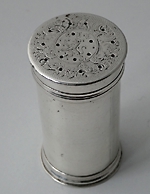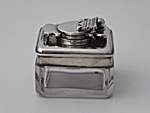Click on |
Description — clicking on underlined text brings up extra full-size images of each piece |
Stock number |
 |
A George IV patent issued by George IV to Sampson Mordan and John Isaac Hawkins in 1822 protecting improvements on the design of propelling pencils (signed by George IV and the Home Secretary, Robert Peel). It also carries the tax stamp, giving it legal status. Price: This patent represents the first attempt to make mechanical pencils, rather than porte crayons, in Britain and received the signature of the King (George IV) and the Home Secretary (Sir Robert Peel). It gave Royal and Government protection to the patentees for 14 years. The recipients were Sampson Mordan (1790-1843), who had been the favourite apprentice of noted maker of patent locks Joseph Bramah, and John Isaac Hawkins, who would go on to invent the iridium pointed gold pen in 1833. From 1822-1823 Mordan and Hawkins were co-patentees but in 1823 Mordan bought Hawkins out and then immediately sold the second half of the patent to Gabriel Riddle, a successful stationer. The combination of Mordan's technological improvements and Riddle's capital and manufacturing experience brought the partnership great success. In 1837, the year after the patent expired, Mordan and Riddle dissolved their partnership. However it's successor, Mordan and Company, became an important firm worldwide in the manufacture of propelling pencils and pens as well as vesta cases, menu holders, wine labels and novelties. It lasted until 1941 when the factory received a direct hit during the Blitz. |
8951 |
 |
A George I tubular sander with engraved lid, by Humphrey Payne of London circa 1715, the lid engraved with the arms and crest of Pearce. Humphrey Payne (d. 1751) was the son of Nicholas Payne, a tallow chandler from Ludlow, and was apprenticed to Roger Grange in 1694 (before being turned over to a new master Thomas Parr). Payne claimed his freedom in November 1701 and registered his first mark later that year. He was a signatory to several petitions against 'stranger goldsmiths' in the 1710s (primarily against the Huguenot silversmiths). He was elected to the Livery of the Goldsmiths' Company in 1708 and served as a Warden from 1747 to 1749. The register of maker's marks at Goldsmiths' Hall records two Britannia standard maker's marks for Payne (numbers 2117 and 2118 in Grimwade's London Goldsmiths) one with a cup above the initials and one with a bird, the one found on this sander. Both seem to be dated 1701 but it is possible that the second was added to the entry prior to 1720 but with no date recorded. Both marks seem to refer to the addresses of his workshops (the Golden Cup from 1701-1720 and the Hen and Chickens from 1720-1755) this could indicate a later date for this sander in the 1720s or 1730s— however the date of the move to Hen and Chickens is not accurately recorded and the form of this sander would seem to be earlier. An inkstand with a similar sander of this unusually tall form appears in the portrait of Sir Roger L'Estrange painted in 1704 by John Michael Wright and now in the National Portrait Gallery in London. The arms on this sander are those of Pearce and appear on the tomb of Zachary Pearce (1690-1774) who was household chaplain to the 1st Earl of Macclesfield (Lord Chief Justice from 1710-1718 and one of the regents between the death of Queen Anne and the arrival of George I in London). Pearce was also a Royal chaplain and was subsequently promoted to be Dean of Winchester, Bishop of St. Asaph and then Rochester and finally Dean of Westminster (he rejected the Bishopric of London preferring this last post). Interestingly he also helped Isaac Newton with his chronology during the latter's last years. If the arms relate to this branch of the Pearce family they could be those of Zachary's father Thomas Pearce (1666-1752), a wealthy distiller who retired to Ealing in around 1710, or either of the latter's two sons- Zachary or William (1692-1782) who had become a brewer. |
7751 |
 |
A George III penner made in Birmingham in 1806 by Joseph Wilmore. Price: £1100.00
|
9008 |
A George III silver-gilt filigree toy inkstand with an enamel base (7.7 cm from left to right and 2.5 cm high) , circa 1790. Price: £1,250.00
|
9798 | |
 |
A William IV glass inkwell with silver 'Berry's Patent' lid, by Henry Berry London 1832 . According to the available literature Berry is recorded as producing travelling inkwells with this mechanism as early as 1832, the date of this example. They were still being advertised in 1853. |
7909 |
| A gold pencil modelled as an umbrella with a pearl forming the handle, unmarked circa 1860 . Price: £385.00 |
6270 | |
 |
A Victorian gold combined fountain pen and mechanical pencil with engraved body and unengraved hardstone matrix, unmarked circa 1870. Price: £345.00 |
8155 |
 |
A glass inkwell with silver mounts, by Thomas and James Phipps London 1817 . Price: £295.00 |
5949 |
 |
A George III desk seal with a wooden handle and silver matrix, unmarked circa 1770, engraved with an armorial (Argent a lion rampant crowned within a bordure engrailed Azure) and crest (a demi-lion rampant out of a crest coronet)- these are apparently adopted. Price: £245.00
|
8750 |
A George V letter opener with cast scroll end and engraved ruler made in London in 1930 by Walter H. Wilson. Price: £245.00
|
9890 | |
 |
A William IV glass ink well with silver top, London 1835 probably Thomas Diller (additionally marked with lion passant on the screw cap) . Price: £245.00 |
7113 |
A George III porte-crayon engraved with a ruler on one side made in Birmingham circa 1800 by Samuel Pemberton. Price:
|
8920 |
|
An Edward VII pen tray made in Sheffield in 1902 by Hawkesworth, Eyre and Company (retailed by George Birley and Company of Worcester), presented to Earl Beauchamp by the Teachers and Children of Callow End Schools for his marriage on July 26th 1902. William Lygon, 7th Earl Beauchamp (1872-1938) inherited the family title and estates in 1891. Following education at Eton College and Christ Church, Oxford (where he was President of the Oxford Union in 1893) Beauchamp served as Mayor of Worcester from 1895-1896. He then began a national political career involving the Governorship of New South Wales (1899-1902), being appointed a Privy Councillor and Captain of the Gentleman at Arms in 1906, Lord Steward from 1907-1910 and President of the Council in 1910. In 1902 Beauchamp married Lady Lettice Mary Elizabeth Grosvenor, daughter of the 1st Duke of Westminster, in 1902 (the event for which this pen tray was presented to him) but in 1931 it became publicly known that Beauchamp was homosexual and he went into self imposed exile on the continent. The departure of the Earl left his estates and houses occupied by his wife and six children. His second son, the Hon. Hugh Lygon, was a contemporary at Oxford of Evelyn Waugh and through their friendship Waugh often stayed at Madresfield, the Worcestershire estate of the Lygon family. Waugh based many of the situations and characters in Brideshead Revisited on the Lygon family (the Chapel at Madresfield is a clear inspiration for that at Brideshead).
|
8352 | |
 |
A hemi-spherical fob-seal with uncut stone decorated with leaves circa 1850. Price: £220.00 |
7500t |
 |
A George III porte-crayon with integral perpetual calendar, unmarked circa 1810.
|
7963z |
 |
An amethyst seal matrix circa 1760, engraved with an armorial (a modern seal impression is included). The arms appear to be a variant on those of Taddy quartering Alwyn or Alwin, Sheppard or Gyde and another. |
7726 |
 |
A George III fob seal made in London circa 1760 by R.G, initialled {T/J B} beneath an escallop (for a member of Barnaby, Barnard, Bidwell, Bottell, Bower, Bridesley or Brownell families).
|
8517 |
 |
A fob seal, circa 1760, engraved with an armorial. Price: £165.00 |
4713 |
 |
A Victorian propelling pencil with hardstone terminal, circa 1840 stamped S. Mordan & Co. Patentees, . Price:  |
6895 |
 |
A George III fob seal ,c. 1780, unmarked, engraved with the arms of the Saxton family (with a slight variant on the crest). The arms on this seal are those of the Saxton family of Cheshire but the crest on it is 'Out of a ducal coronet a hind's head between 2 wings'. The crest of Saxton was 'Out of a ducal coronet a nag's head between 2 wings'. This difference can be ascribed to a mistake, either by the engraver or the owner, or to this seal having been used by another branch of the family who wanted to use this small alteration to make the arms and crest specific to them.
|
8244 |
 |
A George III seal London 1793 by Godbehere and Wigan (overstriking Peter and Ann Bateman), engraved with a female figure holding an anchor for Hope (one of the three Virtues). The biblical link between Hope and the anchor comes from Hebrews 6:19. The image of Hope was used on trinkets in the second half of the eighteenth century — a time when the Navy was expanding. The fact that this seal would not act as a seal suggests another use: snuff boxes were produced with this image and are believed to have served as a sailor's farewell to his family (see Millett and Field Convict Love Tokens (1998) p. 50, and also a pendant in the National Maritime Museum in Greenwich). |
6882 |
 |
A late seventeenth/early eighteenth century small knife (perhaps a quill cutter) with a handle simulating shagreen and steel blade with cutler's mark, European. Price: £145.00 |
6932 |
 |
A letter opener, by Sampson Mordan and Company Chester 1906. Price: £110.00 |
5312 |
 |
A wax impression of a coat of arms in the original lignum vitae box, circa 1835, the arms and crest are those of Perrin . Price: £55.00 |
7727 |
 |
A pencil made in Birmingham in 1899 by William Vale and Sons. Price:
|
9006 |
A pencil, unmarked circa 1900. Price: £20.00
|
9004 | |
 |
A small Victorian propelling pencil, unmarked circa 1860 . Price:  |
7097 |

